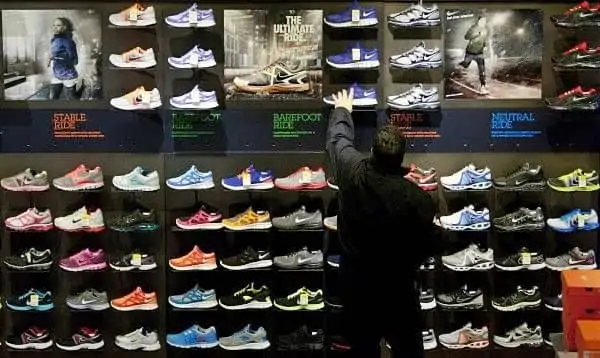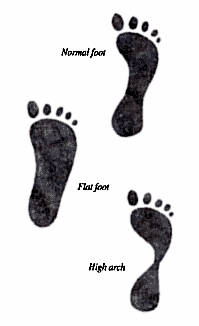
How to Select the Right Athletic Shoes
Too many people choose fashion over function when purchasing athletic shoes, not realizing that poor-fitting shoes can lead to pain throughout the body. Because footwear plays such an important role in the function of bones and joints—especially for runners and other athletes—choosing the right shoe can help prevent pain in your back, hips, knees, and feet.
Unfortunately, there is no such thing as the very best athletic shoe—every pair of feet is different, every shoe has different features, and overall comfort is a very personal decision. For this reason, it is recommended that you first determine your foot type: normal, flat, or high-arched.
- The Normal Foot - Normal feet have a normal-sized arch and will leave a wet footprint that has a flare, but shows the forefoot and heel connected by a broad band. A normal foot lands on the outside of the

- The Flat Foot - This type of foot has a low arch and leaves a print that looks like the whole sole of the foot. It usually indicates an over-pronated foot—one that strikes on the outside of the heel and rolls excessively inward (pronates). Over time, this can cause overuse injuries. Best shoes: Motion-control shoes or high-stability shoes with firm mid-soles. These shoes should be fairly resistant to twisting or bending. Stay away from highly cushioned, highly curved shoes, which lack stability features.
- The High-Arched Foot - The high-arched foot leaves a print showing a very narrow band—or no band at all—between the forefoot and the heel. A curved, highly arched foot is generally supinated or under-pronated. Because the foot doesn’t pronate enough, usually it’s not an effective shock absorber. Best shoes: Cushioned shoes with plenty of flexibility to encourage foot motion. Stay away from motion-control or stability shoes, which reduce foot mobility.
When determining your foot type, consult with your doctor of chiropractic. Dr. Pisarek at Advanced Healthcare (416-633-3000) can help determine your specific foot type, assess your gait using the computerized FootMaxx Gait Scan Analyzer, and then suggest the best shoe match.
Shoe Purchasing Tips:
The best designed shoes in the world will not do their job if they do not fit properly. Proper-fitting sports shoes can enhance performance and prevent injuries.
Consider these ‘fitting’ facts hopefully making you an informed consumer, by following these guidelines when purchasing a new pair of athletic shoes:
- If possible, purchase athletic shoes from a specialty store that specializes in athletic shoes. The staff will provide valuable input on the type of shoe needed for your sport as well as help with proper fitting as they are often trained to recommend a shoe that best matches your foot type (discussed above) and stride pattern. They often know about the different shapes and styles of shoes. This may cost a premium in price but is worthwhile, particularly for shoes that are used often.
- Match the shoe to the activity. Select a shoe specific for the sport in which you will participate. Running shoes are primarily made to absorb shock as the heel strikes the ground. In contrast, tennis shoes provide more side-to-side stability. Walking shoes allow the foot to roll and push off naturally during walking, and they usually have a fairly rigid arch, a well-cushioned sole, and a stiff heel support for stability.
- If possible, shop late in the day when your feet are generally at their largest.
- Wear the type of socks you usually wear during exercise or that particular sport.
- If you use orthotic devices for postural support, make sure you wear them when trying on shoes.
- Have your feet measured every time. It’s important to have the length and width of both feet measured every time you shop for shoes, since foot size often changes with age and most people have 1 foot that is larger than the other. Fit the shoe to the largest foot.
- Many chiropractors, pedorthists and podiatrists suggest that you measure your foot while standing in a weight bearing position because the foot elongates and flattens when you stand, affecting the measurement and the fit of the shoe.
- When the shoe is on your foot, you should be able to freely wiggle all of your toes.
- Make sure the shoe fits correctly. Choose shoes for their fit, not by the size you’ve worn in the past. The shoes should be comfortable as soon as you try them on. There is no break-in period. The shoe should fit with an index finger’s width between the end of the shoe and the longest toe. The toe box should have adequate room and not feel tight. The heel of your foot should fit snugly against the back of the shoe without sliding up or down as you walk or run. If possible, keep the shoe on for 10 minutes to make sure it remains comfortable.
- Walk or run a few steps in your shoes. They should be comfortable.
- Always re-lace the shoes you are trying on. You should begin at the farthest eyelets and apply even pressure as you create a crisscross lacing pattern to the top of the shoe.
- There should be a firm grip of the shoe to your heel. Your heel should not slip as you walk or run.
- If you participate in a sport three or more times a week, you need a sport-specific shoe.
- If you have bunions or hammertoes, find a shoe with a wide toe box. You should be able to fully extend your toes when you're standing, and shoes should be comfortable from the moment you put them on. They will not stretch out.
- Women who have big or wide feet should consider buying men's or boys' shoes, which are cut wider for the same length
- It can be hard to choose from the many different types of athletic shoes available. There are differences in design and variations in material and weight. These differences have been developed to protect the areas of the feet that encounter the most stress in a particular athletic activity.
Athletic shoes are grouped into categories:
- Running, training and walking. This includes shoes for hiking, jogging and exercise walking. For a walking shoe, look for a comfortable soft upper, good shock absorption, smooth tread, and a rocker sole design that encourages the natural roll of the foot during the walking motion. The features of a good jogging shoe include cushioning, flexibility, control and stability in the heel counter area, as well as lightness and good traction.
- Court sports. Includes shoes for tennis, basketball and volleyball. Most court sports require the body to move forward, backward and side-to-side. As a result, most athletic shoes used for court sports are subjected to heavy abuse. The key to finding a good court shoe is its sole.
- Field sports. Includes shoes for soccer football, and baseball. These shoes are cleated, studded or spiked. The spike and stud formations vary from sport to sport, but generally there are replaceable or detachable cleats, spikes or studs affixed onto nylon soles.
- Track and field sport shoes. Because of the specific needs of individual runners, athletic shoe companies produce many models for various foot types, gait patterns and training styles.
- Specialty sports. Includes shoes for golf, aerobic dancing and bicycling.
- Outdoor sports. Includes shoes used for recreational activities such as hunting, fishing and boating.
Know Your Sport Shoes:
If you play a sport three or more times per week, a sport-specific shoe may be necessary. Remember that after 300 to 500 miles of running or 300 hours of aerobic activity, the cushioning material in a shoe is usually worn down and it's time to toss the shoes.
Choices, choices . . .
The fitness boom of the last 25 years has led to an explosion in the manufacture of sports shoes. The sports shoe consumer of the 1960s only had to make one choice: the all-purpose sneaker. Today's consumer must choose from among hundreds of brands and styles of athletic shoes designed for every sport and activity.
You may feel overwhelmed by the choices available to you, particularly since the athletic footwear industry introduces more technologically sophisticated shoes with new designs and features every year. Slick ads and television commercials tout these features, but offer little in the way of advice in selecting the shoes that match your feet. One brand does not meet the needs of everyone, and the latest innovation or most expensive shoe with all the features may not be your best choice.
The information below will help you determine the right shoe for you, the one that will help you enjoy sports and lessen your chance of injury. The information includes what you should look for in sport-specific shoes, features in construction that provide comfort and prevent injuries, how to obtain a proper shoe fit, and shoe adjustments that can be made to treat foot problems.
- Running Shoes:
- Conventional thinking suggests that a good running shoe should have ample cushioning to absorb shock, but there are advocates for minimalist running shoes that have with almost no cushioning. No data exist to say which type of shoe is better, but if you choose a cushioned shoe, look for overall shock absorption for the foot and good heel control. Although not a cure-all, these qualities in a running shoe may help prevent shin splints, tendinitis, heel pain, stress fractures and other overuse syndromes.
- Joggers should wear a shoe with more cushioning impact. Running shoes are designed to provide maximum overall shock absorption for the foot. Such a shoe should also have good heel control. Although not a cure-all, these qualities in a running/sports shoe help prevent shin splints, tendinitis, heel pain, stress fractures and other overuse syndromes.
- Walking Shoes:
- If walking is your sport or your doctor's recommendation for cardiovascular conditioning, wear a lightweight shoe. Look for extra shock absorption in the heel of the shoe and especially under the ball of the foot (the metatarsal area). This will help reduce heel pain (plantar fasciitis and pump bumps) as well as burning and tenderness in the ball of the foot (metatarsalgia). A shoe with a slightly rounded sole or rocker bottom also helps to smoothly shift weight from the heel to the toes while decreasing the forces across the foot. Walking shoes have more rigidity in the front so you can roll off your toes rather than bend through them as you do with running shoes.
- Aerobic Shoes:
- Shoes for aerobic conditioning should be lightweight to prevent foot fatigue and have extra shock absorption in the sole beneath the ball of the foot (metatarsal area), where the most stress occurs. If possible, work out on a carpet.
- Tennis Shoes:
- Tennis players need a shoe that supports the foot during quick side-to-side movements or shifts in weight. A shoe that provides stability on the inside and outside of the foot is an important choice. Flexibility in the sole beneath the ball of the foot allows repeated, quick forward movements for a fast reaction at the net. You need slightly less shock absorption in the shoe if you're playing tennis or other racquet sports. On soft courts, wear a softer soled shoe that allows better traction. On hard courts, you want a sole with greater tread.
- Basketball Shoes:
- If basketball is your sport, choose a shoe with a thick, stiff sole. This gives extra stability when running on the court. A high-top shoe may provide added support but won't necessarily decrease the risk of ankle sprain or injury.
- Cross Trainers:
- Cross-training shoes, or cross trainers, combine several of the above features so that you can participate in more than one sport. A good cross trainer should have the flexibility in the forefoot you need for running combined with the lateral control necessary for aerobics or tennis.
You do not necessarily need a different pair of shoes for every sport in which you participate. Generally, you should wear sport-specific shoes for sports you play more than three times a week. If you have worked out for some time injury-free, then stick with the particular shoe you have been wearing. There is really no reason to change.
For special problems, you may need a special shoe. A well-cushioned shoe may not be a good shoe for someone who over-pronates. If your ankles turn easily, you may need to wear a shoe with a wide heel. If you have trouble with shin splints, you may need a shoe with better shock absorption.
Design Features:
Sport shoes vary in materials and design as well as how they are made. Look inside the shoe before you decide to buy. This will help you select a shoe that fits both your foot and your sport.
Special features in construction give comfort to the wearer as well as help prevent injury:
A slip-lasted shoe is made by sewing together the upper like a moccasin and then gluing it to the sole. This lasting method makes for a lightweight and flexible shoe with no torsional rigidity.
A board-lasted shoe has the "upper" leather or canvas sewn to a cardboard-like material. A person with flat feet (pes planus) feels more support and finds improved control in this type of shoe.
A combination-lasted shoe combines advantages of both other shoes. It is slip-lasted in the front and board-lasted in the back. These shoes give good heel control but remain flexible in the front under the ball of the foot. They are good for a wide variety of foot types.
When Foot Problems Develop:
If you begin to develop foot or ankle problems, simple adjustments in the shoes sometimes can relieve the symptoms. Many of these simple devices are available without prescription.
- A heel cup provides an effective way to alleviate pain beneath the heel (plantar fasciitis). Made of plastic or rubber, the heel cup is designed to give support around the heel while providing relief of pressure beneath the tender spot.
- An arch support (orthosis) can help treat pain in the arch of the foot. Made of many types of materials, arch supports can be placed in a shoe after removing the insole that comes with the shoe.
- A metatarsal pad can help relieve pain beneath the ball of the great toe (sesamoiditis) or beneath the ball of the other toes (metatarsalgia). Made of a felt material or firm rubber, the pad has adhesive on its flat side. Fixed to the insole behind the tender area, the pad shares pressure normally placed on the ball of the foot. This relieves pressure beneath the tender spot.
Custom Arch Supports (Orthotics):
Many problems in the feet respond to stretching and conditioning, choosing a different shoe, and simple over-the-counter shoe modifications. However, long-term (chronic) and complicated problems of the feet may require specially designed inserts (orthotics, orthoses) made of materials that concentrate relief on a particular area while supporting other areas. Severe flat foot, high arches, shin splints, Achilles tendinitis and turf toe are but a few of these conditions.
When determining your foot type, consult with your doctor of chiropractic. Dr. Pisarek at Advanced Healthcare (416-633-3000) also specializes in the correction of non-surgical foot problems. He is trained to treat problems of the foot and ankle, and, can help determine your specific foot type, assess your gait using the computerized FootMaxx Gait Scan Analyzer, and then suggest the best shoe match and customized foot orthotics, if they are required.
How Long Do Shoes Last?
Once you have purchased a pair of athletic shoes, don’t run them into the ground. While estimates vary as to when the best time to replace old shoes is, most experts agree that between 300 and 500 miles is optimal. In fact, most shoes should be replaced even before they begin to show signs of moderate wear. Once shoes show wear, especially in the cushioning layer called the mid-sole, they also begin to lose their shock absorption. Failure to replace worn shoes is a common cause of injuries like shin splints, heel spurs, and plantar fasciitis.
This material was co-developed with the American Academy of Orthopaedic Surgeons.
The American Orthopaedic Foot & Ankle Society (AOFAS)
Remember - Good athletic shoes are part of the good care your feet deserve!
CONTACT US AND SCHEDULE YOUR COMPUTERIZED FOOTMAXX GAIT ANALYSIS

